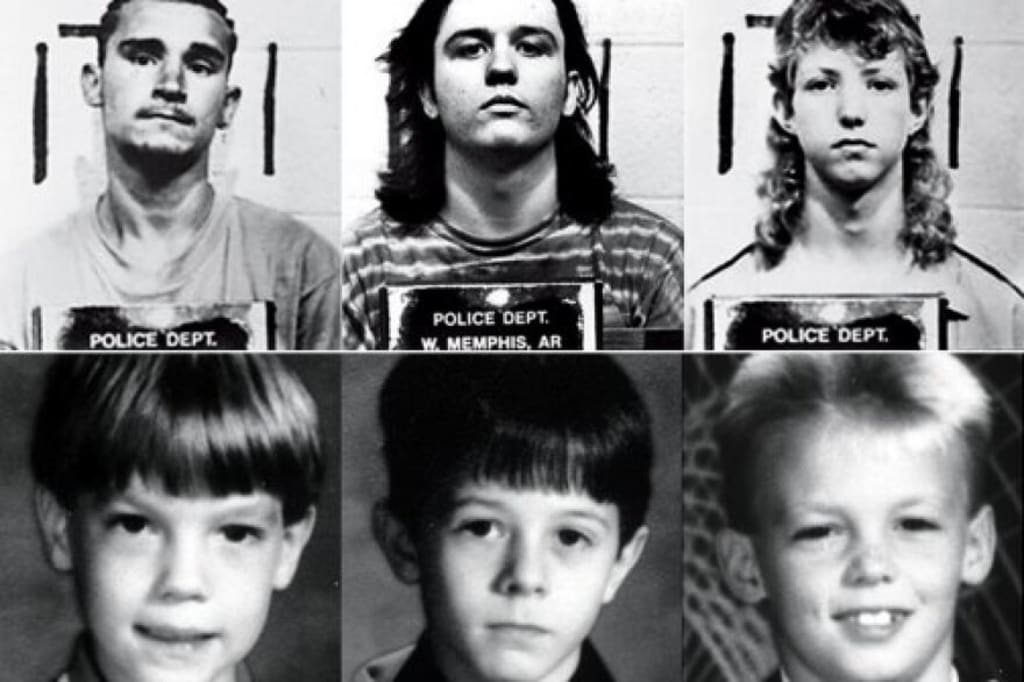Satanic Killers? The West Memphis 3 Murders
Unraveling the Tragic Case of Three Innocent Boys and the Controversial Convictions

In 1993, the small town of West Memphis, Arkansas, was rocked by a tragedy that would forever change its residents. This article delves into the horrific murders of three young boys, the ensuing investigation, and the controversial convictions that have sparked debates for decades.
A Close-Knit Community Shattered
West Memphis was a typical small town, characterized by its conservative, faith-driven community. Neighbors knew each other, kids rode their bikes freely, and crime was almost non-existent. However, on May 5, 1993, the lives of three families were forever altered when eight-year-olds Stevie Branch, Michael Moore, and Christopher Byers went missing after school.
The boys were best friends who enjoyed playing outdoors, throwing rocks in the water, and engaging in Boy Scout activities. That afternoon, they left their homes on their bikes but never returned. Concerned parents started searching when the boys didn’t come home by their usual time.
The Search and Discovery
Christopher's father was the first to alert the police at 7 p.m. The search for the boys intensified as the community rallied together, searching throughout the night with no success. The following day, police and volunteers conducted a more thorough search, focusing on Robin Hood Hills, where the boys were last seen.
At around 1:45 p.m., an investigator found a shoe floating in a creek, leading to the discovery of the boys' bodies. The scene was horrific: the boys were found naked and hogtied with their own shoelaces, with signs of brutal violence. The small town, known for its low crime rate, was now the epicenter of a gruesome murder investigation.
Initial Theories and Investigations
The lack of physical evidence at the crime scene left investigators baffled. The boys' bodies had been in the water, potentially washing away crucial evidence. Early on, the police speculated that more than one perpetrator was involved due to the complexity of the crime.
As the investigation progressed, the community's fear and frustration grew. Rumors of a satanic ritual spread like wildfire, fueled by the boys' brutal deaths and the conservative, religious nature of the town. The pressure to solve the case was immense.
The West Memphis Three
About a month into the investigation, police turned their attention to three local teenagers: Jessie Misskelley Jr., Jason Baldwin, and Damien Echols. These teenagers had a reputation for being different. They were into heavy metal music, wore black clothing, and were considered outcasts. Echols, in particular, was known for his gothic appearance and troubled past, including time spent in a mental institution.
Jessie Misskelley Jr., with an IQ of 72, was interrogated for 12 hours without a lawyer or his parents present. Only 46 minutes of this interrogation were recorded, during which Jessie confessed, implicating Damien and Jason. However, his descriptions of the crime were inconsistent with the facts, leading many to believe his confession was coerced.
Despite this, the confession was enough to arrest the three teenagers, who would become known as the West Memphis Three. The community was divided; some believed the case was solved, while others felt the real killers were still out there.
The Trials and Convictions
The trials of the West Memphis Three were highly publicized and contentious. The prosecution focused heavily on the idea of a satanic ritual, a notion that resonated with the conservative town. Damien's interest in occult practices and his gothic appearance were used against him, painting a picture of a satanic killer.
Despite the lack of physical evidence linking the teenagers to the crime, Damien Echols was sentenced to death, while Jason Baldwin and Jessie Misskelley Jr. received life sentences. The convictions were based largely on Jessie's questionable confession and the community's fear of satanic rituals.
New Evidence and Release
Years later, advances in DNA testing revealed no physical evidence connecting the West Memphis Three to the crime scene. Instead, DNA found at the scene did not match any of the three teenagers. This new evidence, along with growing public support and high-profile advocates, led to their release in 2011 after they entered Alford pleas. This legal move allowed them to maintain their innocence while acknowledging that the prosecution had enough evidence to convict them.
The Aftermath and Ongoing Search for Justice
Since their release, the West Memphis Three have continued to fight for a full exoneration and the reopening of the investigation to find the true killers. Their case has drawn significant media attention, leading to documentaries, books, and widespread debate.
The tragic murders of Stevie Branch, Michael Moore, and Christopher Byers remain unsolved, leaving their families and the community without closure. The handling of the investigation and subsequent convictions highlight the dangers of rushed judgments and societal prejudices.
About the Creator
Sally A
Animal lover 🐾 | Health enthusiast 💪 | Self-development junkie 🌱 | Beauty explorer 💄 | True crimes & mystery enthusiast 🕵️♀️ | Let's journey together! 💫
Enjoyed the story? Support the Creator.
Subscribe for free to receive all their stories in your feed. You could also pledge your support or give them a one-off tip, letting them know you appreciate their work.






Comments
There are no comments for this story
Be the first to respond and start the conversation.